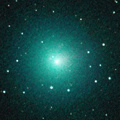
|
Now it is very bright as 6.7 mag (Feb. 7, Marco Goiato). It is approaching to Earth down to 0.3 a.u., and it is observable in excellent condition.
Date(TT) R.A. (2000) Decl. Delta r Elong. m1 Best Time(A, h)
Feb. 9 11 27.20 3 26.8 0.338 1.287 148 6.3 2:19 (180, 53)
Feb. 16 8 36.38 27 36.6 0.327 1.294 156 6.3 22:38 (180, 26)
|

|
It approached to Earth down to 0.08 a.u. in mid December, and it brightened up to 3.4 mag (Dec. 14, Seiichi Yoshida). it looked so large as 3 times of Moon. Now it is fading. But it is bright as 7.3 mag still now (Feb. 5, Carlos Labordena). In the Northern Hemisphere, it stays observable in excellent condition. In the Southern Hemisphere, it stays low for a while.
Date(TT) R.A. (2000) Decl. Delta r Elong. m1 Best Time(A, h)
Feb. 9 9 30.36 52 28.4 0.374 1.304 142 8.2 0:17 (180, 2)
Feb. 16 9 33.33 50 11.6 0.433 1.356 142 9.0 23:49 (180, 5)
|

|
It brightened up to 7.7 mag in June (June 19, Juan Jose Gonzalez). Now it is fading. But it is still bright as 11.1 mag (Feb. 4, Chris Wyatt). In the Southern Hemisphere, it stays observable in good condition for a long time until the comet will fade out. In the Northern Hemisphere, it is not observable for a long time until autumn when the comet fades out down to 16 mag.
Date(TT) R.A. (2000) Decl. Delta r Elong. m1 Best Time(A, h)
Feb. 9 3 2.15 -71 33.0 3.137 3.015 73 11.5 20:33 ( 19, 48)
Feb. 16 3 17.82 -68 13.1 3.173 3.066 74 11.6 20:24 ( 23, 49)
|

|
It brightened up to 9.0 mag from autumn to winter (Nov. 16, Maik Meyer). Now it is fading. But it is bright as 11.2 mag still now (Feb. 4, Chris Wyatt). It is observable in excellent condition in the Northern Hemisphere. It stays low in the Southern Hemisphere.
Date(TT) R.A. (2000) Decl. Delta r Elong. m1 Best Time(A, h)
Feb. 9 4 27.69 26 16.3 1.204 1.795 109 11.5 20:33 (160, 26)
Feb. 16 4 42.95 25 50.8 1.309 1.844 105 12.0 20:24 (159, 26)
|
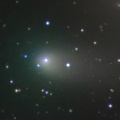
|
It brightened up to 9.5 mag from autumn to winter (Dec. 14, Marco Goiato). Now it is fading. But it is bright as 11.2 mag still now (Feb. 5, Carlos Labordena). In the Northern Hemisphere, it stays observable in good condition for a long time until it fades out. It locates low in the Southern Hemispehre.
Date(TT) R.A. (2000) Decl. Delta r Elong. m1 Best Time(A, h)
Feb. 9 8 26.69 47 28.4 1.048 1.940 145 11.8 23:10 (180, 8)
Feb. 16 8 26.47 47 17.0 1.125 1.989 140 12.2 22:42 (180, 8)
|
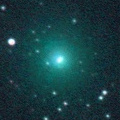
|
Now it is 12.2 mag (Feb. 2, Ken Harikae). It will be fading gradually after this. In the Northern Hemisphere, it stays observable for a long time until it fades out. But it stays extremely low. It will never be observable again in the Southern Hemisphere.
Date(TT) R.A. (2000) Decl. Delta r Elong. m1 Best Time(A, h)
Feb. 9 21 3.32 32 5.2 2.454 1.928 47 12.1 3:53 (255,-40)
Feb. 16 21 27.54 34 10.9 2.502 1.970 47 12.4 4:03 (251,-38)
|

|
Now it is 13.5 mag (Jan. 27, Toshihiko Ikemura, Hirohisa Sato). It stays at 12-13 mag for a long time until autumn.
Date(TT) R.A. (2000) Decl. Delta r Elong. m1 Best Time(A, h)
Feb. 9 0 8.33 1 43.2 2.669 2.060 42 12.5 20:33 ( 94, 3)
Feb. 16 0 22.97 3 2.1 2.708 2.048 39 12.5 20:24 ( 95, 1)
|

|
Now it is 13.0 mag (Feb. 4, Chris Wyatt). It will be fading after this.
Date(TT) R.A. (2000) Decl. Delta r Elong. m1 Best Time(A, h)
Feb. 9 6 3.52 -22 15.1 2.835 3.406 117 13.2 20:46 (180, 77)
Feb. 16 5 54.68 -22 7.6 2.963 3.449 111 13.4 20:24 (166, 77)
|

|
Now it is 12.9 mag (Feb. 3, Chris Wyatt). It is observable in excellent condition in the Northern Hemisphere. It locates low in the Southern Hemisphere.
Date(TT) R.A. (2000) Decl. Delta r Elong. m1 Best Time(A, h)
Feb. 9 11 38.96 31 0.4 1.236 2.127 146 13.3 2:25 (180, 24)
Feb. 16 11 35.77 31 30.9 1.214 2.129 150 13.3 1:55 (180, 24)
|
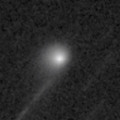
|
Now it is 14.6 mag (Jan. 22, Thomas Lehmann). It will brighten up to 10-11 mag in autumn. It will be unobservable temporarily in March.
Date(TT) R.A. (2000) Decl. Delta r Elong. m1 Best Time(A, h)
Feb. 9 1 6.97 -23 40.3 4.603 4.071 52 13.4 20:33 ( 80, 28)
Feb. 16 1 9.62 -21 50.9 4.639 4.030 46 13.4 20:24 ( 80, 24)
|

|
Now it is 15.0 mag (Feb. 6, Jean-Francois Soulier).
Date(TT) R.A. (2000) Decl. Delta r Elong. m1 Best Time(A, h)
Feb. 9 23 23.09 2 25.5 6.566 5.767 33 13.8 20:33 ( 88, -7)
Feb. 16 23 28.06 2 57.5 6.623 5.767 27 13.8 20:24 ( 87,-10)
|

|
Now it is 13.9 mag (Jan. 19, Martin Masek). It stays 13-14 mag until summer.
Date(TT) R.A. (2000) Decl. Delta r Elong. m1 Best Time(A, h)
Feb. 9 17 29.39 -17 6.9 3.685 3.258 57 14.0 3:53 (271, 29)
Feb. 16 17 31.29 -18 24.0 3.579 3.263 63 13.9 4:03 (267, 37)
|
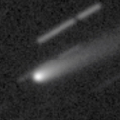
|
Now it is 13.5 mag (Jan. 28, Thomas Lehmann). It will be fading after this, and it will be fainter than 18 mag in May.
Date(TT) R.A. (2000) Decl. Delta r Elong. m1 Best Time(A, h)
Feb. 9 11 47.33 -6 9.1 0.851 1.725 139 14.0 2:34 (180, 61)
Feb. 16 11 46.16 -6 24.6 0.838 1.749 146 14.1 2:05 (180, 62)
|

|
Now it is 15.2 mag (Feb. 1, Toshihiko Ikemura, Hirohisa Sato).It will be fading slowly after this. It is observable in good condition in the Northern Hemisphere. In the Southern Hemisphere, it stays extremely low for a while.
Date(TT) R.A. (2000) Decl. Delta r Elong. m1 Best Time(A, h)
Feb. 9 15 59.84 43 1.7 3.627 3.834 94 14.3 3:53 (210, 3)
Feb. 16 16 2.83 43 43.3 3.630 3.883 97 14.4 4:03 (204, 5)
|
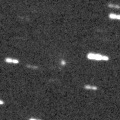
|
Now it is bright as 14.8 mag (Dec. 12, Kunihiro Shima). It stays 14 mag for a long time in 2019. In the Southern Hemisphere, it is observable in excellent condition. In the Northern Hemisphere, it is not observasble until summer in 2020.
Date(TT) R.A. (2000) Decl. Delta r Elong. m1 Best Time(A, h)
Feb. 9 10 38.12 -55 12.3 2.866 3.312 108 14.5 1:25 ( 0, 70)
Feb. 16 10 20.37 -57 6.8 2.815 3.288 110 14.5 0:40 ( 0, 68)
|

|
Now it is 14.5 mag (Jan. 31, Toshihiko Ikemura, Hirohisa Sato). It will be fading slowly after this. It is observable in excellent condition until spring in the Northern Hemispehre. In the Southern Hemisphere, it will be hardly observable after this.
Date(TT) R.A. (2000) Decl. Delta r Elong. m1 Best Time(A, h)
Feb. 9 10 32.49 44 0.2 3.975 4.839 147 14.5 1:20 (180, 11)
Feb. 16 10 18.51 44 17.7 4.010 4.876 147 14.6 0:38 (180, 11)
|

|
Now it is 14.3 mag (Nov. 30, Seiichi Yoshida). It will be fading gradually after this. It is observable in excellent condition in the Northern Hemisphere. In the Southern Hemisphere, it is not observable until summer.
Date(TT) R.A. (2000) Decl. Delta r Elong. m1 Best Time(A, h)
Feb. 9 11 23.42 80 57.0 1.629 2.207 112 14.7 2:12 (180,-26)
Feb. 16 10 41.48 79 51.3 1.667 2.239 112 14.8 1:03 (180,-25)
|

|
Now it is 14.5 mag (Aug. 16, P. Camilleri, H. Williams). It stays 15 mag from 2018 to 2019, and it will be observable for a long time in the Southern Hemisphere. In the Northern Hemisphere, it will never be observable again.
Date(TT) R.A. (2000) Decl. Delta r Elong. m1 Best Time(A, h)
Feb. 9 21 38.56 -59 8.7 4.567 3.922 44 14.9 20:33 ( 27, 15)
Feb. 16 21 54.61 -57 54.3 4.554 3.923 45 14.9 4:03 (332, 15)
|

|
Now it is 14.5 mag (Jan. 27, Toshihiko Ikemura, Hirohisa Sato). It is expected to brighten up to 7-8 mag in 2020. It will be unobservable temporarily in April.
Date(TT) R.A. (2000) Decl. Delta r Elong. m1 Best Time(A, h)
Feb. 9 2 58.78 -0 29.8 5.353 5.319 82 15.4 20:33 (121, 37)
Feb. 16 2 59.37 0 17.7 5.403 5.257 76 15.4 20:24 (118, 34)
|
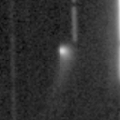
|
Now it is 14.6 mag (Jan. 21, Sandor Szabo). It stays 15 mag until March. It is observable in excellent condition in the Northern Hemisphere. It is not observable at all in the Southern Hemisphere.
Date(TT) R.A. (2000) Decl. Delta r Elong. m1 Best Time(A, h)
Feb. 9 4 42.52 71 55.3 2.818 3.287 109 15.4 20:33 (174,-17)
Feb. 16 4 16.23 69 7.5 2.918 3.293 103 15.5 20:24 (170,-16)
|

|
It brightened up to 6.8 mag in September (Sept. 17, Seiichi Yoshida). Now it is fading. It has already faded down to 15.3 mag (Jan. 30, Toshihiko Ikemura, Hirohisa Sato). It is observable in excellent condition in the Southern Hemisphere. It locates low after this in the Northern Hemisphere.
Date(TT) R.A. (2000) Decl. Delta r Elong. m1 Best Time(A, h)
Feb. 9 6 5.40 -24 34.9 1.512 2.144 116 15.4 20:49 (180, 79)
Feb. 16 6 7.48 -22 8.6 1.610 2.206 114 15.8 20:24 (179, 77)
|

|
Although it was faint as 16-17 mag in November, it brightened up to 14.7 mag in December (Dec. 12, Toshihiko Ikemura, Hirohisa Sato). It is bright as 15.1 mag still now (Jan. 31, Toshihiko Ikemura, Hirohisa Sato). In the Northern Hemisphere, it stays observable in excellent condition after this. It stays extremely low in the Southern Hemisphere.
Date(TT) R.A. (2000) Decl. Delta r Elong. m1 Best Time(A, h)
Feb. 9 11 15.28 41 7.1 2.041 2.905 145 15.6 2:02 (180, 14)
Feb. 16 11 9.41 42 1.4 2.060 2.935 146 15.8 1:29 (180, 13)
|

|
First return of a new periodic comet discovered in 2014. It has not been recovered yet. Now it is not detected, fainter than 20.0 mag (Dec. 10, Toshihiko Ikemura, Hirohisa Sato). The condition of this apparition is excelllent. It is expected to brighten rapidly, and to be observable at 15.5 mag in excellent condition in March.
Date(TT) R.A. (2000) Decl. Delta r Elong. m1 Best Time(A, h)
Feb. 9 10 26.69 7 36.6 0.888 1.857 163 16.4 1:13 (180, 48)
Feb. 16 10 23.33 8 11.5 0.849 1.833 171 16.3 0:43 (180, 47)
|
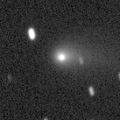
|
Now it is 16.0 mag (Jan. 27, Toshihiko Ikemura, Hirohisa Sato). It will be unobservable soon.
Date(TT) R.A. (2000) Decl. Delta r Elong. m1 Best Time(A, h)
Feb. 9 1 3.45 -4 8.7 2.875 2.430 53 16.3 20:33 ( 98, 17)
Feb. 16 1 14.81 -2 38.8 2.970 2.458 50 16.6 20:24 ( 98, 15)
|
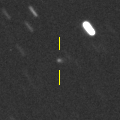
|
It is expected to brighten up to 10 mag in autumn. Now it is 16.7 mag (Feb. 1, Toshihiko Ikemura, Hirohisa Sato). In the Northern Hemisphere, it stays observable for a long time while the comet is brightening. In the Southern Hemisphere, it it not observable until mid September.
Date(TT) R.A. (2000) Decl. Delta r Elong. m1 Best Time(A, h)
Feb. 9 14 33.72 73 12.9 2.622 3.076 108 16.5 3:53 (186,-19)
Feb. 16 14 46.72 77 9.4 2.578 3.006 106 16.3 4:03 (184,-22)
|

|
Now it is 16.8 mag (Jan. 31, Toshihiko Ikemura, Hirohisa Sato). It stays 16-17 mag for a long time until 2020. It is observable in good condition in the Northern Hemisphere. It is not observable at all in the Southern Hemisphere.
Date(TT) R.A. (2000) Decl. Delta r Elong. m1 Best Time(A, h)
Feb. 9 11 47.56 73 55.4 7.940 8.446 117 16.6 2:34 (180,-19)
Feb. 16 11 41.88 74 9.5 7.957 8.446 116 16.6 2:01 (180,-19)
|
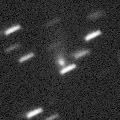
|
It brightened up to 8.7 mag in July (July 18, Marco Goiato). Then it faded down to 12.3 mag in August (Aug. 29, Chris Wyatt). It stays observable in good condition after this while the comet will be fading.
Date(TT) R.A. (2000) Decl. Delta r Elong. m1 Best Time(A, h)
Feb. 9 16 26.39 -16 3.7 3.357 3.199 72 16.7 3:53 (260, 42)
Feb. 16 16 27.81 -15 3.6 3.319 3.280 79 16.8 4:03 (252, 48)
|
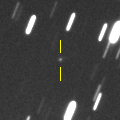
|
Now it is 16.6 mag (Feb. 1, Toshihiko Ikemura, Hirohisa Sato). It continues brightening even after the perihelion passage. It stays observable at 16-17 mag in good condition for some more time.
Date(TT) R.A. (2000) Decl. Delta r Elong. m1 Best Time(A, h)
Feb. 9 8 5.18 -2 21.0 0.739 1.680 153 16.7 22:48 (180, 57)
Feb. 16 8 5.41 -2 31.5 0.772 1.695 148 16.7 22:21 (180, 58)
|
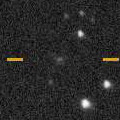
|
Now it is 17.4 mag (Jan. 3, Toshihiko Ikemura, Hirohisa Sato). It stays 16 mag for a long time from 2019 to 2020. It is observable in excellent condition in the Southern Hemisphere. It is hardly observable in the Northern Hemisphere.
Date(TT) R.A. (2000) Decl. Delta r Elong. m1 Best Time(A, h)
Feb. 9 14 17.16 -44 5.2 4.230 4.375 91 17.0 3:53 (309, 74)
Feb. 16 14 15.04 -45 50.1 4.094 4.338 97 16.9 4:03 (334, 78)
|
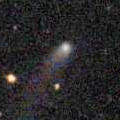
|
It brightened up to 14.7 mag in early 2018 (Jan. 25, Catalina Sky Survey). Now it is fading slowly. Now it is 16.7 mag (Feb. 2, Toshihiko Ikemura, Hirohisa Sato). In the Northern Hemisphere, it stays observable in good condition for a long time until the comet fades out. It is never observable again in the Southern Hemisphere.
Date(TT) R.A. (2000) Decl. Delta r Elong. m1 Best Time(A, h)
Feb. 9 4 38.24 71 30.1 5.842 6.243 109 17.0 20:33 (174,-17)
Feb. 16 4 27.46 70 49.9 5.949 6.270 104 17.0 20:24 (172,-17)
|

|
Now it is 17.1 mag (Feb. 1, Toshihiko Ikemura, Hirohisa Sato). It will be fading after this, and it will be fainter than 18 mag in late March. It locates somewhat low in the Southern Hemisphere.
Date(TT) R.A. (2000) Decl. Delta r Elong. m1 Best Time(A, h)
Feb. 9 7 58.30 22 34.9 1.664 2.603 157 17.1 22:41 (180, 32)
Feb. 16 7 54.66 22 13.5 1.725 2.625 149 17.2 22:10 (180, 33)
|

|
Now it is 16.8 mag (Jan. 29, Toshihiko Ikemura, Hirohisa Sato). It will be fading after this, and it will be fainter than 18 mag in March.
Date(TT) R.A. (2000) Decl. Delta r Elong. m1 Best Time(A, h)
Feb. 9 4 39.01 22 26.2 1.171 1.789 111 17.2 20:33 (161, 30)
Feb. 16 4 48.23 24 36.4 1.242 1.798 106 17.3 20:24 (160, 27)
|

|
Now it is 17.2 mag (Feb. 2, Toshihiko Ikemura, Hirohisa Sato). Fading slowly. It stays observable at 17 mag in good condition until summer.
Date(TT) R.A. (2000) Decl. Delta r Elong. m1 Best Time(A, h)
Feb. 9 11 41.82 7 20.2 9.140 9.977 146 17.2 2:28 (180, 48)
Feb. 16 11 40.74 7 39.5 9.092 9.988 153 17.2 2:00 (180, 47)
|

|
Now it is 16.8 mag (Feb. 1, Toshihiko Ikemura, Hirohisa Sato). It is observable at 17 mag in good condition in 2019. It locates somewhat low in the Northern Hemisphere.
Date(TT) R.A. (2000) Decl. Delta r Elong. m1 Best Time(A, h)
Feb. 9 15 42.73 -15 45.7 3.760 3.763 82 17.2 3:53 (251, 50)
Feb. 16 15 47.16 -15 59.3 3.663 3.771 88 17.2 4:03 (243, 57)
|
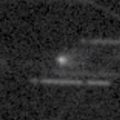
|
Now it is 17.0 mag (Jan. 29, Toshihiko Ikemura, Hirohisa Sato). It will be fading after this, and it will be fainter than 18 mag in March. It locates low in the Southern Hemisphere.
Date(TT) R.A. (2000) Decl. Delta r Elong. m1 Best Time(A, h)
Feb. 9 11 7.59 29 22.5 1.858 2.774 152 17.2 1:54 (180, 26)
Feb. 16 11 1.45 30 22.8 1.879 2.813 156 17.3 1:21 (180, 25)
|
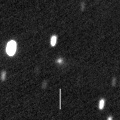
|
Now it is 17.0 mag (Feb. 1, Toshihiko Ikemura, Hirohisa Sato). It will be fading after this, and it will be fainter than 18 mag in May. It locates very low in the Southern Hemisphere.
Date(TT) R.A. (2000) Decl. Delta r Elong. m1 Best Time(A, h)
Feb. 9 5 44.73 43 42.1 3.253 3.900 124 17.3 20:33 (179, 11)
Feb. 16 5 44.50 43 30.6 3.349 3.914 118 17.3 20:24 (176, 11)
|

|
Now it is 16.9 mag (Feb. 2, Toshihiko Ikemura, Hirohisa Sato). It is expected to be observable at 5-6 mag for a long time from 2022 to 2023. It will be observable in good condition for a long time in the Southern Hemisphere. In the Northern Hemisphere, it is not observable at the highlight from 2022 summer to 2023 summer.
Date(TT) R.A. (2000) Decl. Delta r Elong. m1 Best Time(A, h)
Feb. 9 18 4.95 52 33.3 12.418 12.293 80 17.4 3:53 (218,-19)
Feb. 16 18 7.35 52 53.2 12.353 12.248 81 17.3 4:03 (215,-15)
|

|
Now it is 17.7 mag (Feb. 2, Toshihiko Ikemura, Hirohisa Sato). In the Northern Hemisphere, it is observable at 17.5 mag in good condition in February. It is not observable in the Southern Hemisphere.
Date(TT) R.A. (2000) Decl. Delta r Elong. m1 Best Time(A, h)
Feb. 9 8 51.52 71 46.2 0.927 1.681 122 17.6 23:21 (180,-16)
Feb. 16 6 41.00 64 26.8 0.939 1.654 118 17.5 20:52 (180, -9)
|
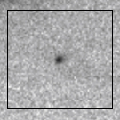
|
Now it is 17.7 mag (Jan. 31, Toshihiko Ikemura, Hirohisa Sato). It will be fading after this, and it will be fainter than 18 mag in late February. It locates very low in the Southern Hemisphere.
Date(TT) R.A. (2000) Decl. Delta r Elong. m1 Best Time(A, h)
Feb. 9 11 21.42 38 30.9 0.759 1.670 145 17.6 2:08 (180, 17)
Feb. 16 11 15.99 38 34.0 0.782 1.704 148 17.8 1:35 (180, 17)
|
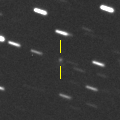
|
Now it is 17.6 mag (Jan. 30, Toshihiko Ikemura, Hirohisa Sato). It stays 17 mag from spring to summer. But it is hardly observable. In the Northern Hemisphere, it is observable only until May. In the Southern Hemisphere, it stays locating extremely low.
Date(TT) R.A. (2000) Decl. Delta r Elong. m1 Best Time(A, h)
Feb. 9 3 49.74 47 12.6 2.309 2.728 104 17.7 20:33 (160, 4)
Feb. 16 3 56.81 46 20.4 2.339 2.681 99 17.6 20:24 (158, 4)
|

|
Now it is 17.7 mag (Jan. 29, Toshihiko Ikemura, Hirohisa Sato). It will be fading after this, and it will be fainter than 18 mag in April.
Date(TT) R.A. (2000) Decl. Delta r Elong. m1 Best Time(A, h)
Feb. 9 4 23.44 3 54.8 7.817 8.117 104 17.7 20:33 (148, 46)
Feb. 16 4 21.17 3 53.9 7.947 8.127 97 17.7 20:24 (142, 44)
|

|
Main-belt asteroid. But it shows a straight tail like a comet. Now it is 17.3 mag (Feb. 4, Toshihiko Ikemura, Hirohisa Sato). It stays observable in excellent condition until early summer.
Date(TT) R.A. (2000) Decl. Delta r Elong. m1 Best Time(A, h)
Feb. 9 10 38.41 -11 10.6 1.509 2.407 148 17.9 1:25 (180, 66)
Feb. 16 10 33.10 -10 5.0 1.458 2.392 155 17.8 0:52 (180, 65)
|
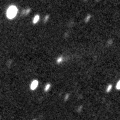
|
Now it is 17.1 mag (Jan. 29, Toshihiko Ikemura, Hirohisa Sato). It will be fading after this, and it will be fainter than 18 mag in late February.
Date(TT) R.A. (2000) Decl. Delta r Elong. m1 Best Time(A, h)
Feb. 9 6 50.46 3 57.0 2.329 3.146 139 17.8 21:34 (180, 51)
Feb. 16 6 49.18 4 30.7 2.408 3.167 133 17.9 21:05 (180, 50)
|
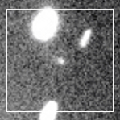
|
Now it is 17.5 mag (Jan. 29, Toshihiko Ikemura, Hirohisa Sato). First return of a new periodic comet which brightened up to 16 mag in 2011. It will be fading after this, and it will be fainter than 18 mag in March.
Date(TT) R.A. (2000) Decl. Delta r Elong. m1 Best Time(A, h)
Feb. 9 3 9.80 11 57.6 2.157 2.351 88 17.8 20:33 (134, 30)
Feb. 16 3 18.79 12 14.5 2.233 2.343 83 17.8 20:24 (132, 28)
|
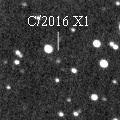
|
Now it is 17.5 mag (Jan. 29, Toshihiko Ikemura, Hirohisa Sato). It is observable at 18 mag in winter.
Date(TT) R.A. (2000) Decl. Delta r Elong. m1 Best Time(A, h)
Feb. 9 7 10.52 3 53.1 6.757 7.580 144 17.9 21:54 (180, 51)
Feb. 16 7 9.04 3 54.9 6.816 7.577 137 18.0 21:25 (180, 51)
|
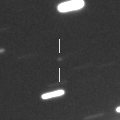
|
Now it is 17.8 mag (Feb. 1, Toshihiko Ikemura, Hirohisa Sato). It is observable at 18 mag in good condition from January to February. It locates low in the Southern Hemisphere.
Date(TT) R.A. (2000) Decl. Delta r Elong. m1 Best Time(A, h)
Feb. 9 10 36.98 30 45.7 1.011 1.960 157 17.9 1:24 (180, 24)
Feb. 16 10 30.02 29 44.5 1.019 1.979 161 18.0 0:49 (180, 25)
|
|
![]()
 C/2017 B3 ( LINEAR )
C/2017 B3 ( LINEAR ) C/2017 T2 ( PanSTARRS )
C/2017 T2 ( PanSTARRS ) C/2018 A3 ( ATLAS )
C/2018 A3 ( ATLAS ) 21P/Giacobini-Zinner
21P/Giacobini-Zinner 240P/NEAT
240P/NEAT P/2014 C1 ( TOTAS )
P/2014 C1 ( TOTAS ) 48P/Johnson
48P/Johnson C/2018 W2 ( Africano )
C/2018 W2 ( Africano ) C/2010 U3 ( Boattini )
C/2010 U3 ( Boattini ) C/2017 T3 ( ATLAS )
C/2017 T3 ( ATLAS ) 239P/LINEAR
239P/LINEAR C/2018 F4 ( PanSTARRS )
C/2018 F4 ( PanSTARRS ) C/2016 A1 ( PanSTARRS )
C/2016 A1 ( PanSTARRS ) 59P/Kearns-Kwee
59P/Kearns-Kwee 171P/Spahr
171P/Spahr C/2014 B1 ( Schwartz )
C/2014 B1 ( Schwartz ) 74P/Smirnova-Chernykh
74P/Smirnova-Chernykh 164P/Christensen
164P/Christensen 159P/LONEOS
159P/LONEOS C/2017 K2 ( PanSTARRS )
C/2017 K2 ( PanSTARRS ) C/2019 B1 ( Africano )
C/2019 B1 ( Africano ) 247P/LINEAR
247P/LINEAR C/2018 X2 ( Fitzsimmons )
C/2018 X2 ( Fitzsimmons ) C/2015 XY1 ( Lemmon )
C/2015 XY1 ( Lemmon ) (6478) Gault
(6478) Gault 361P/2017 S4 ( Spacewatch )
361P/2017 S4 ( Spacewatch ) 373P/2018 R2 ( Rinner )
373P/2018 R2 ( Rinner ) C/2016 X1 ( Lemmon )
C/2016 X1 ( Lemmon ) 375P/2018 T1 ( Hill )
375P/2018 T1 ( Hill )![]()










































